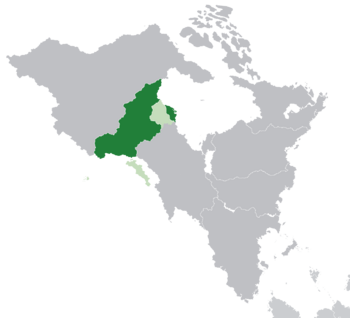Enyama
This article is incomplete because it is pending further input from participants, or it is a work-in-progress by one author. Please comment on this article's talk page to share your input, comments and questions. Note: To contribute to this article, you may need to seek help from the author(s) of this page. |
Enyama
Ahíá Niborea | |
|---|---|
International Flag (Forum of Nations)
| |
 Territory of Enyama in dark green; Greater Enyama in light green | |
| Status | Failed state |
| Largest cities |
|
| Spoken languages | |
| Ethnic groups |
|
| Religion |
|
| Demonym(s) | Enyaman |
| Establishment | |
• Founding of the Wabayan Shamandom | 396 CE |
• First Belisarian Settlers | 980 CE |
• First Ochranese Settlers | 1043 CE |
• Enyaman Revolution and Independence from Tsurushima | 1893 CE |
• Karasuna Incident and New Constitution | 1989 CE |
• Enyaman Civil War and political disintegration | 2019 CE-present |
| Area | |
• Total | 1,413,632 km2 (545,806 sq mi) |
• Water (%) | 5% |
| Population | |
• 2018 estimate | 38,783,232 |
• Density | 27.4/km2 (71.0/sq mi) |
| Time zone | West Norumbian Time (WNT) |
| Date format | yyyy-mm-dd |
| Driving side | varies |
| Calling code | +20 |
| Internet TLD | .ey |
Enyama (Enyaman: 에냐마, tr. E-nya-ma), also known as Ahíá and Niborea, is region and former nation-state of approximately 38 million inhabitants situated in northwestern Norumbia. It is bordered to its south by its historical rival, Elatia; it also shares maritime borders with Walzenia. The Enyaman region consists of a core situated in the Lagawa Depression, surrounded to the northwest by the Great Expanse and Kalopere Mountains and to the southeast by the Eternal Mountains on the Elatian border. The most populous ethnic group in the region are the Enyamans, descendants of mixing between Tsurushimese, Wabayan, and Haratago groups. Other important groups include the Norinnians, descendants of Belisarian colonists and the Wiyátamánwit people, Elatians, Tsurushimese, and Anágans.
Etymology
The Enyaman and Tsurushiman word for Enyama is "圓山", meaning "round mountain". The character en (圓) means "round" or otherwise refers to currency; yama (山) means "mountain" or "pile". The compound, therefore, means "round mountain" and is likely derived from the clearly visible peak of the Daimaru, an isolated mountain near the western port city of Fujikawa, where Tsurushiman settlers first arrived in Enyama in 1271. In the New Ochranian script, Enyama is rendered phonetically as "에냐마".
History
Evidence of Norumbian hunter-gatherers in the Lagawa Depression stretches back before 100,000 BCE. These nomadic tribes, especially on the western end of the region, had garnered extensive knowledge of various animals, domesticating animals such as Wapiti and Yak and begun to consolidate into larger social groups. Archeological evidence indicates that these tribes had begun to settle into a lifestyle of semi-nomadic pastoralism around 4000 BCE. Several pre-colonial migrations appear to have occurred in the following millennia, with some considerable mingling occurring across the White Mountains with Runakuna city-states; Haratago tribes also entered into the area and often exchanged resources and tools with local tribes. Among these resources was cold-resistant Enyaman sorghum, which many tribes took to farming, sparking an agricultural revolution and leading to consolidation of the Wabayan Shamandom in 396 CE. On the northern coast, the Wiyátamánwit Confederacy established itself soon afterwards after mastering sorghum and other crops, including maize imported from the Kayamuca Empire.
Pre-Colonial Era
The Wabayan Shamandom, itself a widely diverse nation of widely differing tribes and groups including, prominently, the Anágans and Haratago, soon became the pre-eminent force in the Lagawa river valley, mastering the river's unpredictable flood cycle and reaching a population of over one million by 600 CE. Though many remained nomadic or semi-nomadic, owing to the harsh winters and abundance of wild animals, many in the Wabayan culture began to settle down in large settlements. The de facto capital of the Shamandom was Wahkanea in the south-east of modern Enyama; the city's stone ruins persist to this day and are considered to be prime examples of Wabayan architecture. Wabayan culture remained open to syncretization of belief and mixing between different ethnic groups, however, a political rift began to form between the proto-states in the region, and particularly between the Wiyátamánwit and the Wabayan. The Wiyátamánwit had retained their egalitarian roots with the formation of the Confederacy. The governing body of the Confederacy was the tribal Council of Many, which received delegates from the nation's various subtribes, typically the second-born or second-most-important man in the tribe. This brought them at odds with the increasingly centralized Wabayan, which were ruled by a Great Shaman.
Around the 890s CE, the Wabayan had a large internal conflict which destabilized the nations' rising influence, often referred to as the Wabayan Civil War. The war appeared to have started when one particularly powerful warlord which had gained the trust of several tribes, Kohana, attempted to establish a monarchy. Though Kohana was defeated, many of the tribes which had supported him left the Confederacy and either joined the Wiyátamánwit Confederacy or remained on their own, and the Shamandom began to lose its influence over the majority of the Lagawa river, becoming a regionally-contained but still powerful nation centered around Wahkanea by 1000 CE.
Colonial Era
From the late 10th century onwards, Enyama was subject to colonization from both Belisarian and Ochranese elements: Ottonian settlers and warriors arrived along the eastern coastline in 980 CE, followed in 1049 by Latin settlers, centuries before the Belfrasian Crusade. A loose organization of Ottonians and Latins on the coast established polities, including the Colony of Ala Nova and the Duchy of Innonland, which also stretched into modern Elatia. Tsurushiman settlers arrived on the west coast in 1043, and promptly established the trading outposts of Fujikawa and Soubiro. Despite the inefficient methods of transportation available to the Tsurushiman settlers, the revelation of a continent in the east spurred economic curiosity, leading to a wave of immigration. This first influx is now known as the First Wave of Fujikawa.
By 1252, Enyama was a full-fledged colony of Tsurushima, and a prominent source of both raw materials and cash crops, which were grown largely through indentured servitude.
Loss of Contact and Colonial Wars
Era of Tsurushiman Domination
Enyaman Revolution and Terramoto Era
In 1889, Enyaman allegiance to the First Tsurushimese Republic began to hit falter in the wake of neglectful political culture and a general feeling of exploitation. Unlike past civil movements, the Movement for Greater Enyaman Autonomy, which formed in January of 1890, was more ethnically and culturally diverse. Although concurrent political strife on mainland Tsurushima had largely been socialist in nature, the only-partially-industrialized Enyaman colony took more to libertarian and especially geolibertarian thought, with the thought of abolishing private property entirely upsetting many who had emigrated to Norumbia in search of a more lucrative and secure life. Throughout 1891, many samurai began to shave their heads in symbolic protest of what was percieved as Tsurushimese domination.
Enyama experienced revolution which culminated in a violent overthrow of the colonial government and waning in Tsurushiman influence of the government; Enyama had formally gained its independence soon afterward in late 1893. Operating out of the fast-growing river city and the new capital of Karasuna, the new Federal States of Enyama reconstituted its position on both the land's original native inhabitants and its Belisarian minority, offering amnesty to those displaced by colonists or otherwise disenfranchised. With its borders fully explored and exploited by 1880, Enyama emerged into the new century as a regional power, keeping itself largely pacifist in the face of regional conflicts. The Federal States was characterized by its largely libertarian and lax attitude towards migration, leading to the arrival of many foreigners seeking opportunity, particularly from Tsurushima.
ELATIAN WAR NAME TBD
Reform of Eight
Economic Expansion
Enyama joined the Forum of Nations soon after its creation in 1966.
After a hard economic depression in 1970, Enyama began to lose its reputation as a "land of opportunity" and instead garnered a reputation as a highly polluted and fairly overpopulated land. An attempted Syndicalist revolution in 1989, its roots having originated in Enyama's ever-increasing economic strife, failed drastically but led to a general increase in paranoia and security. In 2005, current President Muratagi Eijiro and his New Frontier party came into office, immediately increasing military spending and geopolitical posturing particularly against southern neighbor Elatia. Muratagi's rise to power was seen as a shock by many both nationally and internationally, and has led to several accusations of illiberality against Enyama; in 2011, world democracy experts reclassified Enyama as an illiberal democracy. The nation has since garnered criticism for its allegedly harsh treatment of its Skaldanian minority. Despite the fact that its economy has not fully evolved into the 21st century and still relies on a manufacturing base, Enyama nevertheless can be considered a highly militarized state. Since 1990, Enyama has also had immense problems with organized crime, particularly the mafia and triads of large urban centers; recent measures have drastically curbed this crime wave.
